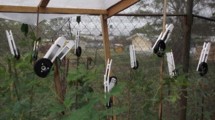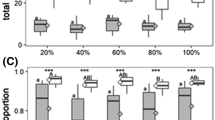Abstract
Artificial light at night (ALAN) has been shown to alter aspects of plant growth, but we are not aware of any studies that have examined whether the effects of ALAN on plants depend upon the backdrop of variation in other abiotic factors that plants encounter in field populations. We conducted a field experiment to investigate whether ALAN affects the growth and anti-herbivore defenses of common milkweed, Asclepias syriaca, and whether the effects of ALAN are influenced by plant density or soil moisture content. Artificial light at night, soil moisture, and plant density were manipulated according to a split-plot factorial design. Although increasing soil moisture by watering had no significant effects on latex exudation, attributes of plant growth generally responded positively to watering. The basal stem diameter (BSD) and height of plants were affected by ALAN × soil moisture interactions. For both of these variables, the positive effects of ALAN were greater for plants that were not watered than for plants that were. Basal stem diameter was also affected by an ALAN × plant density interaction, and the positive effect of ALAN on BSD was greater in the low-density treatment than in the high-density treatment. Our results demonstrate that the effects of ALAN on plant growth can be altered by soil moisture and plant density. Consequently, the effects of ALAN on plants in nature may not be consistent with existing frameworks that do not account for critical abiotic variables such as water availability or biotic interactions between plants such as competition.


Similar content being viewed by others
References
Agrawal AA, Fishbein M (2006) Plant defense syndromes. Ecology 87(sp7):S132–S149. https://doi.org/10.1890/0012-9658(2006)87[132:PDS]2.0.CO;2
Agrawal AA, Konno K (2009) Latex: a model for understanding mechanisms, ecology, and evolution of plant defense against herbivory. Annu Rev Ecol Evol Syst 40:311–331. https://doi.org/10.1146/annurev.ecolsys.110308.120307
Agrawal AA, Malcolm SB (2002) Once upon a milkweed—in this complex community, one insect’s poison may be another’s meal. Natural History September 2002
Agrawal AA, Patrick ET, Hastings AP (2014) Tests of the coupled expression of latex and cardenolide plant defense in common milkweed (Asclepias syriaca). Ecosphere 5:1–11. https://doi.org/10.1890/ES14-00161.1
Bates D, Mächler M, Bolker B, Walker S (2014) Fitting linear mixed-effects models using lme4. arXiv preprint arXiv:1406.5823
Bennie J, Davies TW, Cruse D, Inger R, Gaston KJ (2015) Cascading effects of artificial light at night: resource-mediated control of herbivores in a grassland ecosystem. Philos Trans R Soc B 370:20140131. https://doi.org/10.1098/rstb.2014.0131
Bennie J, Davies TW, Cruse D, Gaston KJ (2016) Ecological effects of artificial light at night on wild plants. J Ecol 104:611–620. https://doi.org/10.1111/1365-2745.12551
Bennie J, Davies TW, Cruse D, Bell F, Gaston KJ (2017) Artificial light at night alters grassland vegetation species composition and phenology. J Appl Ecol 55:442–450. https://doi.org/10.1111/1365-2664.12927
Bennie J, Davies TW, Cruse D, Inger R, Gaston KJ (2018) Artificial light at night causes top-down and bottom-up trophic effects on invertebrate populations. J Appl Ecol 55(6):2698–2706. https://doi.org/10.1111/1365-2664.13240
Briggs WR (2006) Physiology of plant responses to artificial lighting. In: Rich C, Longcore T (eds) Ecological consequences of artificial night lighting. Island Press, Washington DC, pp 389–406
Cathey HM, Campbell LE (1975) Security lighting and its impact on the landscape. J Arboric 1:181–187
Couture JJ, Serbin SP, Townsend PA (2015) Elevated temperature and periodic water stress alter growth and quality of common milkweed (Asclepias syriaca) and monarch (Danaus plexippus) larval performance. Arthropod-Plant Interact 9:149–161. https://doi.org/10.1007/s11829-015-9367-y
Darko E, Heydarizadeh P, Schoefs B, Sabzalian MR (2014) Photosynthesis under artificial light: the shift in primary and secondary metabolism. Philos Trans R Soc B Biol Sci 369(1640):20130243. https://doi.org/10.1098/rstb.2013.0243
Davies TW, Bennie J, Gaston KJ (2012) Street lighting changes the composition of invertebrate communities. Biol Lett 8(5):764–767. https://doi.org/10.1098/rsbl.2012.0216
Davies TW, Bennie J, Cruse D et al (2017) Multiple night-time light-emitting diode lighting strategies impact grassland invertebrate assemblages. Glob Chang Biol 23:2641–2648. https://doi.org/10.1111/gcb.13615
Falchi F, Cinzano P, Duriscoe D, Kyba CC, Elvidge CD, Baugh K et al (2016) The new world atlas of artificial night sky brightness. Sci Adv 2(6):e1600377. https://doi.org/10.1126/sciadv.1600377
Farnworth B, Innes J, Kelly C, Littler R, Waas JR (2018) Photons and foraging: artificial light at night generates avoidance behaviour in male, but not female, New Zealand weta. Environ Pollut 236:82–90. https://doi.org/10.1016/j.envpol.2018.01.039
Firebaugh A, Haynes KJ (2019) Light pollution may create demographic traps for nocturnal insects. Basic Appl Ecol 34:118–125. https://doi.org/10.1016/j.baae.2018.07.005
Gaston KJ, Bennie J, Davies TW, Hopkins J (2013) The ecological impacts of nighttime light pollution: a mechanistic appraisal. Biol Rev 88:912–927. https://doi.org/10.1111/brv.12036
Goins GD, Yorio NC, Sanwo-Lewandowski MM, Brown CS (1998) Life cycle experiments with Arabidopsis under red light-emitting diodes (LEDs). Life Support Biosph Sci 5:143–149
Greenham K, McClung CR (2015) Integrating circadian dynamics with physiological processes in plants. Nat Rev Genet 16:598–610. https://doi.org/10.1038/nrg3976
Grenis K, Murphy SM (2019) Direct and indirect effects of light pollution on the performance of an herbivorous insect. Insect Sci 26:770–776. https://doi.org/10.1111/1744-7917.12574
Guo Y, Logan HL, Glueck DH, Muller KE (2013) Selecting a sample size for studies with repeated measures. BMC Med Res Methodol 13(1):100. https://doi.org/10.1186/1471-2288-13-100
Huot B, Yao J, Montgomery BL, He SY (2014) Growth-defense tradeoffs in plants: a balancing act to optimize fitness. Mol Plant 7:1267–1287. https://doi.org/10.1093/mp/ssu049
Jin X, Li Y, Zhang J, Zheng J, Liu H (2017) An approach to evaluating light pollution in residential zones: a case study of Beijing. Sustainability 9(4):652
Knop E, Zoller L, Ryser R et al (2017) Artificial light at night as a new threat to pollination. Nature 548:206–209. https://doi.org/10.1038/nature23288
Kuznetsova A, Brockhoff PB, Christensen RH (2017) lmerTest package: tests in linear mixed effects models. J Stat Softw 82(13):3–12
Kwak MJ, Lee SH, Khaine I, Je SM, Lee TY, You HN, Lee HK, Jang JH, Kim I, Woo SY (2017) Stomatal movements depend on interactions between external night light cue and internal signals activated by rhythmic starch turnover and abscisic acid (ABA) levels at dawn and dusk. Acta Physiol Plant 39(8):162
Kwak MJ, Je SM, Cheng HC, Seo SM, Park JH, Baek SG, Khaine I, Lee T, Jang J, Li Y, Kim H (2018) Night light-adaptation strategies for photosynthetic apparatus in yellow-poplar (Liriodendron tulipifera L.) exposed to artificial night lighting. Forests 9(2):74. https://doi.org/10.3390/f9020074
Lawson T, Blatt MR (2014) Stomatal size, speed, and responsiveness impact on photosynthesis and water use efficiency. Plant Physiol 164(4):1556–1570. https://doi.org/10.1104/pp.114.237107
Lind EM, Borer E, Seabloom E et al (2013) Life-history constraints in grassland plant species: a growth-defence trade-off is the norm. Ecol Lett 16:513–521. https://doi.org/10.1111/ele.12078
Longcore T, Rich C (2004) Ecological light pollution. Front Ecol Environ 2:191–198. https://doi.org/10.1890/1540-9295(2004)002[0191:ELP]2.0.CO;2
Macgregor CJ, Evans DM, Fox R, Pocock MJO (2017) The dark side of street lighting: impacts on moths and evidence for the disruption of nocturnal pollen transport. Glob Chang Biol 23:697–707. https://doi.org/10.1111/gcb.13371
Malcolm SB, Zalucki MP (1996) Milkweed latex and cardenolide induction may resolve the lethal plant defence paradox. In: Proceedings of the 9th international symposium on insect-plant relationships, pp 193–196
Nichter A, Gregory A (2018) Distribution modeling of Asclepias spp. predicts potential conservation benefits of marginal ecosystems as nature reserves in Northwest Ohio. Nat Areas J 38(4):250–259. https://doi.org/10.3375/043.038.0405
R Core Team (2019) R: a language and environment for statistical 1031 computing. Vienna, Austria: R Foundation for Statistical Computing 1032
Robertson FC, Skeffington AW, Gardner MJ, Webb AA (2009) Interactions between circadian and hormonal signaling in plants. Plant Mol Biol 69(4):419. https://doi.org/10.1007/s11103-008-9407-4
Sanders D, Kehoe R, Tiley K et al (2015) Artificial nighttime light changes aphid-parasitoid population dynamics. Sci Rep 5:15232. https://doi.org/10.1038/srep15232
Van Zandt PA, Agrawal AA (2004) Specificity of induced plant responses to specialist herbivores of the common milkweed Asclepias syriaca. Oikos 104(2):401–409. https://doi.org/10.1111/j.0030-1299.2004.12964.x
Witherington BE, Martin RE (2000) Understanding, assessing, and resolving light-pollution problems on sea turtle nesting beaches. Florida Marine Research Institute. Technical Report TR-2
Züst T, Agrawal AA (2017) Trade-offs between plant growth and defense against insect herbivory: an emerging mechanistic synthesis. Annu Rev Plant Biol 68:513–534. https://doi.org/10.1146/annurev-arplant-042916-040856
Acknowledgements
We would like to thank Brandon Fox and Dennis Heflin for the installing the experimental lighting infrastructure, Amoi Campbell for field assistance, and the staff of Blandy Experimental Farm for supporting original research in many ways.
Funding
This study was funded by NSF REU Site Grants DBI 1156796 and DBI 1659816.
Author information
Authors and Affiliations
Contributions
MH, KH, DR, DC, and ED conceived and designed the experiments. MH and ED performed the experiments. MH, DC, and KH analyzed the data. ED wrote the initial manuscript, which MH, DR, DC, and KH subsequently revised and edited.
Corresponding author
Ethics declarations
Conflict of interest
The authors declare that they have no conflict of interest.
Additional information
Communicated by Casey P. terHorst.
Electronic supplementary material
Below is the link to the electronic supplementary material.
Rights and permissions
About this article
Cite this article
Hey, M.H., DiBiase, E., Roach, D.A. et al. Interactions between artificial light at night, soil moisture, and plant density affect the growth of a perennial wildflower. Oecologia 193, 503–510 (2020). https://doi.org/10.1007/s00442-020-04679-9
Received:
Accepted:
Published:
Issue Date:
DOI: https://doi.org/10.1007/s00442-020-04679-9




